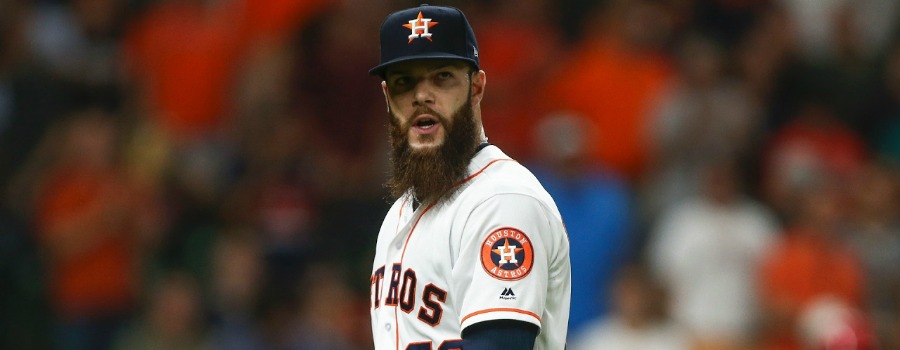This is a weekly series that follows MLB trends created with our Trends tool. Although the trends in this series are made with specific slates in mind, they are designed to remain relevant throughout the season.
8/28/17
We know that in most sports, including MLB, DraftKings uses variable pricing to consider a player’s matchup. One thought I’ve often had in regard to DraftKings’ pricing when analyzing a player’s matchup is this: Have other players had their salaries adjusted at a similar rate as the player I am analyzing in the same matchup? If yes, how have those players performed against salary-implied expectations?
If one night, we have an ace pitching in Arizona and DraftKings has lowered this ace’s salary $1,000 due to the matchup, is his matchup-adjusted salary now enticing enough to take a shot? By looking at past examples, we can see if DraftKings generally tends to over-adjust pitchers in this same matchup. If that’s the case, we’d see a high Plus/Minus score in Trends.
On Monday, Corey Kluber was in New York for a date with the Yankees. Although Kluber did not come cheap with a price tag of $13,100 on DraftKings, this still represented a discount since he had recently been priced at $14,000, $13,500, and $13,400. Using the ‘Opposing Team,’ ‘MLB Season,’ and ‘Month Salary Change’ filters via our Trends tool, I found that pitchers whose salaries have been down between $500 to $1,000 over the past month ahead of their matchup with the Yankees in 2017 have collectively achieved a +2.87 Plus/Minus on 68 percent Consistency (25 starts). In this case, it did seem like DraftKings was over-correcting pitchers when they face the Yankees.
Results
If Kluber was already relatively cheap to begin with, he became a steal once we learned Aaron Judge would not be in the Yankees lineup. Per our Vegas Dashboard, the Yankees’ implied run total fell 0.6 points from 3.9 to 3.3 over the course of the day. Kluber was chalky – averaging 27.33 percent ownership per our Ownership Dashboard – but not prohibitively so considering the presence of several other highly-owned options including Max Scherzer, Andrew Heaney, and Luis Severino. He did just fine in his matchup against the Yankees, racking up seven strikeouts in eight innings and finishing with 29.6 fantasy points.
8/29
This next trend comes at the suggestion of Twitter user @ahosier2, who aimed to create a trend to help neutralize our biases as we evaluate strong, consistent pitchers late in the season. There are many filters available for use in our Trends tool that can be used to determine which pitchers are allowing hard and soft contact. I’ve personally leaned towards ground ball vs. fly ball percentage here, but one similar filter I have not really touched on in this series to this point is airtime. Airtime measures the average airtime of batted balls allowed by the pitcher. While ground balls and fly balls are, to an extent, arbitrary, airtime is measured precisely in fractions of seconds. By combining an above-average airtime allowed with a low line drive percentage, we’ve created a cohort that should consist of pitchers who make things easy on their defense.
We can then look for matchups that will suit this type of pitcher by looking at opposing lineups whose collective average distance on batted balls is below average. I added a couple of additional filters to exclude small samples (Season Count must be greater than 10) and low-upside pitchers (K Prediction must be at least six) and found these results:

Tuesday’s match was Ervin Santana, whose airtime and line drive numbers were supported by a low 29 percent hard hit rate. The batters the opposing White Sox started on Tuesday collectively averaged 198 feet on batted balls, making them roughly equivalent to a lineup comprised of Ryan Goins nine times over.
Results
Though relatively popular on DraftKings at an average of 21.33 percent ownership, Santana was able to limit Chicago to three earned runs over 6.2 innings, posting a +3.2 Plus/Minus.
8/30
As the city of Houston recovers from Hurricane Harvey, the Astros are playing a series of ‘home’ games at Tropicana Field in Tampa Bay. Wednesday’s starter for the Astros, Dallas Keuchel, is the owner of some of the most notorious home/road splits in baseball:

Keuchel scores roughly six more fantasy points per game in Houston, where he is 21 percent more consistent. He is a different pitcher depending on the venue, and everyone knows it, as evidenced by his massive ownership splits.
The question on Wednesday then became this: Does Keuchel perform better in Houston specifically or will any ‘home’ game do? Although the crowd at Tropicana would not be comprised of Houstonians as usual, you would still have to expect the crowd to rally behind the Astros in the wake of Harvey.
Results
It may not have been a true ‘home’ game, but players rostered Keuchel as if it were. Keuchel averaged 38.07 percent ownership across the four contests our Ownership Dashboard tracks. Additionally, Keuchel was rostered 10 percent more frequently in the $2,650 buy-in Broken Bat than he was in the $8 Rally Cap, which resulted in an excellent GPP Grade. Unfortunately, road-game Keuchel showed up to Tampa. With six runs allowed in six innings, Keuchel scored 10.7 fantasy points, finishing well below expectations.
——
Thanks for following along with my three custom trends this week. As always, there’s plenty more left to be explored via the Labs Tools.




